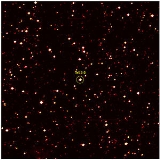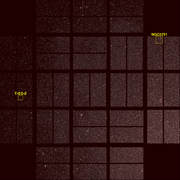
GSC 03549-02811
Encyclopedia
GSC
03549-02811 A (referred to in the exoplanet literature as TrES-2) is a yellow main-sequence
star
similar to our Sun
. This star is located approximately 718 light-year
s away in the constellation
of Draco
. The apparent magnitude
of this star is 11.41, which means it is not visible to the naked eye
but can be seen with a medium-sized amateur telescope
on a clear dark night. The age of this star is about 5 billion years.
program using the transit method. It is also within the field of view of the now-operational Kepler Mission
planet-hunter spacecraft. This system continues to be studied by other projects and the parameters are continuously improved. The planet orbits the primary star.
Though TrES-2b is currently the darkest known exoplanet, reflecting less than 1 percent of local sunlight, it does show a faint red glow. It is assumed to be tidally locked
to its parent star.
in Spain
. This star system, along with two others, was determined to be a previously unknown binary star
system. The previously unknown secondary star is a dim magnitude
15 K-type star separated by about 232 AU
from the primary, appearing offset from the primary by about one arc second in the images. This discovery resulted in a significant recalculation of parameters for both the planet and the primary star.
 In March 2009 NASA launched the Kepler Mission spacecraft. This spacecraft is a dedicated mission to discover extrasolar planets by the transit method from solar orbit. In April 2009 the project released the first light images from the spacecraft and TrES-2b was one of two objects highlighted in these images. Although TrES-2b is not the only known exoplanet in the field of view of this spacecraft it is the only one identified in the first light images. This object is important for calibration and check-out.
In March 2009 NASA launched the Kepler Mission spacecraft. This spacecraft is a dedicated mission to discover extrasolar planets by the transit method from solar orbit. In April 2009 the project released the first light images from the spacecraft and TrES-2b was one of two objects highlighted in these images. Although TrES-2b is not the only known exoplanet in the field of view of this spacecraft it is the only one identified in the first light images. This object is important for calibration and check-out.
Guide Star Catalog
The Guide Star Catalog is also known as the Hubble Space Telescope, Guide Catalog . It is a star catalog compiled to support the Hubble Space Telescope with targeting off-axis stars. GSC-I contained approximately 20,000,000 stars with apparent magnitudes of 6 to 15. GSC-II contains 945,592,683...
03549-02811 A (referred to in the exoplanet literature as TrES-2) is a yellow main-sequence
Main sequence
The main sequence is a continuous and distinctive band of stars that appears on plots of stellar color versus brightness. These color-magnitude plots are known as Hertzsprung–Russell diagrams after their co-developers, Ejnar Hertzsprung and Henry Norris Russell...
star
Star
A star is a massive, luminous sphere of plasma held together by gravity. At the end of its lifetime, a star can also contain a proportion of degenerate matter. The nearest star to Earth is the Sun, which is the source of most of the energy on Earth...
similar to our Sun
Sun
The Sun is the star at the center of the Solar System. It is almost perfectly spherical and consists of hot plasma interwoven with magnetic fields...
. This star is located approximately 718 light-year
Light-year
A light-year, also light year or lightyear is a unit of length, equal to just under 10 trillion kilometres...
s away in the constellation
Constellation
In modern astronomy, a constellation is an internationally defined area of the celestial sphere. These areas are grouped around asterisms, patterns formed by prominent stars within apparent proximity to one another on Earth's night sky....
of Draco
Draco (constellation)
Draco is a constellation in the far northern sky. Its name is Latin for dragon. Draco is circumpolar for many observers in the northern hemisphere...
. The apparent magnitude
Apparent magnitude
The apparent magnitude of a celestial body is a measure of its brightness as seen by an observer on Earth, adjusted to the value it would have in the absence of the atmosphere...
of this star is 11.41, which means it is not visible to the naked eye
Naked eye
The naked eye is a figure of speech referring to human visual perception unaided by a magnifying or light-collecting optical device, such as a telescope or microscope. Vision corrected to normal acuity using corrective lenses is considered "naked"...
but can be seen with a medium-sized amateur telescope
Telescope
A telescope is an instrument that aids in the observation of remote objects by collecting electromagnetic radiation . The first known practical telescopes were invented in the Netherlands at the beginning of the 1600s , using glass lenses...
on a clear dark night. The age of this star is about 5 billion years.
Planetary system
In 2006 the exoplanet TrES-2b was discovered by the TrESTres
The tres is a 3-course, 6-string chordophone which was created in Cuba. A tres player is called a tresero in Cuba and a tresista in Puerto Rico.-Cuban tres:In Cuba, the son was created as a song and a salon dance genre...
program using the transit method. It is also within the field of view of the now-operational Kepler Mission
Kepler Mission
The Kepler spacecraft is an American space observatory, the space-based portion of NASA's Kepler Mission to discover Earth-like planets orbiting other stars. The spacecraft is named in honor of the 17th-century German astronomer Johannes Kepler...
planet-hunter spacecraft. This system continues to be studied by other projects and the parameters are continuously improved. The planet orbits the primary star.
Though TrES-2b is currently the darkest known exoplanet, reflecting less than 1 percent of local sunlight, it does show a faint red glow. It is assumed to be tidally locked
Tidal locking
Tidal locking occurs when the gravitational gradient makes one side of an astronomical body always face another; for example, the same side of the Earth's Moon always faces the Earth. A tidally locked body takes just as long to rotate around its own axis as it does to revolve around its partner...
to its parent star.
Binary star
In 2008 a study was undertaken of fourteen stars with exoplanets that were originally discovered using the transit method through relatively small telescopes. These systems were re-examined with the 2.2M reflector telescope at the Calar Alto ObservatoryCalar Alto Observatory
The Calar Alto Observatory is an astronomical observatory owned and operated jointly by the Max-Planck-Institut für Astronomie in Heidelberg, Germany, and the Instituto...
in Spain
Spain
Spain , officially the Kingdom of Spain languages]] under the European Charter for Regional or Minority Languages. In each of these, Spain's official name is as follows:;;;;;;), is a country and member state of the European Union located in southwestern Europe on the Iberian Peninsula...
. This star system, along with two others, was determined to be a previously unknown binary star
Binary star
A binary star is a star system consisting of two stars orbiting around their common center of mass. The brighter star is called the primary and the other is its companion star, comes, or secondary...
system. The previously unknown secondary star is a dim magnitude
Apparent magnitude
The apparent magnitude of a celestial body is a measure of its brightness as seen by an observer on Earth, adjusted to the value it would have in the absence of the atmosphere...
15 K-type star separated by about 232 AU
Astronomical unit
An astronomical unit is a unit of length equal to about or approximately the mean Earth–Sun distance....
from the primary, appearing offset from the primary by about one arc second in the images. This discovery resulted in a significant recalculation of parameters for both the planet and the primary star.
The Kepler Mission


